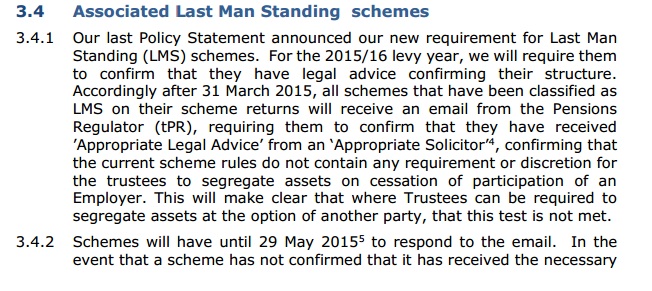Problems could lie ahead for schemes seeking to qualify as 'last man standing' when completing their annual scheme returns.
LMS multi-employer schemes are eligible to pay a reduced Pension Protection Fund levy because the insolvency of an individual employer will not result in the related part of the scheme being passed on to the PPF.
But pensions lawyers have identified a discrepancy between documents issued by the PPF and the Pensions Regulator regarding the classification of multi-employer schemes as such.
There is currently a misalignment between criteria laid out by the PPF in its levy determination for 2015/2016 and a subsequent policy statement, both released in December last year.
Robert West, partner at law firm Baker & McKenzie, said: “There is some uncertainty as to whether schemes categorized in the past as last man standing will necessarily qualify… this time around.”
LMS multi-employer schemes are eligible to pay a reduced Pension Protection Fund levy because the insolvency of an individual employer will not result in the related part of the scheme being passed onto the PPF.
But pensions lawyers have identified a discrepancy between documents issued by the PPF and the Pensions Regulator regarding the classification of multi-employer schemes as such.
There is currently a misalignment between criteria laid out by the PPF in its levy determination for 2015/2016 and a subsequent policy statement, both released in December last year, lawyers say (update: see response from the PPF at the bottom of the blog).
Robert West, partner at law firm Baker & McKenzie, said: “There is some uncertainty as to whether schemes categorized in the past as last man standing will necessarily qualify… this time around.”
In the past, when filling out annual return forms, schemes had to tick one of four boxes declaring the scheme’s structure.

Source: The Pensions Regulator
The PPF’s new determination for this year’s levy will require an additional step to avoid misreporting on scheme structures.
All schemes that have been classified as a LMS scheme on their scheme returns will be contacted by the regulator after March 31 2015, requiring them to certify that they have received legal advice regarding their structure. Schemes must respond by May 29 2015.
The PPF’s determination states: “All schemes that have been classified as LMS on their scheme returns will receive an email from the Pensions Regulator, requiring them to confirm that they have received appropriate legal advice from an appropriate solicitor.”
In a policy statement following the determination the PPF added a sentence stating that when the regulator writes to schemes it will “make clear that where the trustees can be required to segregate assets at the opinion of another party that this test is not met.”

Source: The Pension Protection Fund
“That’s were the discrepancy is,” said West. “It does call into question the treatment of schemes where there is a partial winding-up rule. With pension schemes there is a wide variety of permutations… whether there is a partial winding up provision at all and secondly how it is triggered.”
Failure to communicate
Marcus Fink, partner at law firm Ashurst, said it was unsurprising the PPF was seeking a further qualifying standard but thought a “meeting of minds” between the PPF and the regulator, along with a set of specific guidelines, was required to clarify the issue.
“This is a very important question,” said Fink. “It makes sense for them to have a joined-up approach but we’ve seen evidence here there is no join up on this matter between the two organisations.”
Anne-Marie Winton, partner at law firm Nabarro, said: “It would have been good to have the regulator and the PPF speaking to each other and saying the same thing.”
Winton said that without further guidance, clients and trustees may struggle to answer scheme return forms substantively.
“It’s geeky but importantly geeky, we will be getting questions about this,” said Winton. The PPF published a series of FAQs on LMS criteria on February 20, but they do not directly address this issue.
Update: The PPF has responded to this blog saying the definition of 'last man standing' in its levy rules and that used in the Pensions Regulator's scheme return have always been the same.
In a statement, it added: "However, if the employer has the opportunity to segregate following insolvency, it does not present a lower risk to the PPF and therefore it will not qualify for a levy discount. A change was made to our rules and to Exchange in 2014/15 to reflect this, and is set out on the face of the scheme return.
"Schemes should therefore already be reporting on this basis and the email from [the regulator] will simply remind schemes of the approach expected. We'd welcome any scheme or an adviser with a query about their specific circumstances to get in touch.”














